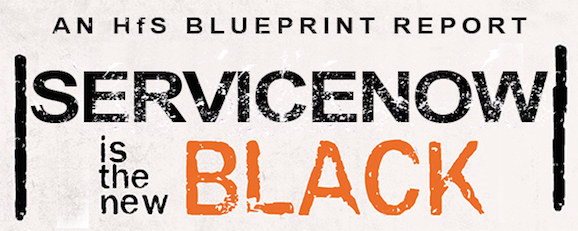There is a lot of buzz about ServiceNow technology. Thousands of developers and partners made their pilgrimage to Knowledge 16, ServiceNow’s customer event in Las Vegas. Service providers are starting to standardize service delivery on the ServiceNow platform and M&A is helping to build out service providers capabilities, as in the case of CSC acquiring Aspediens. Even though ServiceNow tends to position itself as the Enterprise Cloud Company, industry stakeholders are rather enthusiastic about the single data model, the embedded workflows and new ways of collaboration. As such, ServiceNow has the potential to evolve into one of the key building blocks for moving toward As-a-Service because its core value proposition centers on clients accelerating their time to value through faster actions and interactions, overcoming clunky legacy solutions like ITSM.
Buoyed by such buzz and enthusiasm, ServiceNow is aiming to expand the notion of service management to evolving into the “third estate between CRM and ERP,” providing a new cloud-based level of efficiency between the front and back offices. Thus, there are many touch points with the HfS notion of the OneOffice: Digitally driven enterprises must create a Digital Underbelly to support the front office by automating manual processes, digitizing manual documents and leveraging smart devices and IoT where they are present in the value chain. As a result, ServiceNow can be part of a broader innovation ecosystem in which the ability to orchestrate and integrate will become the pivot for creating value and differentiation. Nonetheless, as HfS has stated repeatedly, it is not just about the technology or solution ideals of the As-a-Service Economy, but about the change ideals in equal measure.
Here is the crucial question: How are organizations advancing their innovation agendas?
The recent HfS ServiceNow Services Blueprint highlighted two key issues in that respect: First, ServiceNow itself has been slow in embracing the notion of an ecosystem that goes beyond treating partners as mere sales channels. Thus, co-innovation with partners around vertical offerings and other innovation had not been high on the agenda. This is starting to change though, which is critical as the notion of the As-a-Service Economy is predicated on a collaborative partner ecosystem. Second, there are issues for service providers as well to address as many clients were unhappy with the lack of innovation driven by their supplier. The most successful projects were those in which clients drove the innovation process. This points to a crucial aspect for the journey toward the As-a-Service Economy. The eventual success is less about the technology building blocks and more about a change in mindset.
As the ServiceNow Services Blueprint shows, many clients need help in understanding the direction of travel. What vision do innovations like ServiceNow support? One compelling example for such a change in mindset came on a recent visit to an Atos delivery center in Barcelona that is supporting the 2016 Rio Olympics. It is a shift in mindset because Atos is treating the Olympics as a transformation project. The firm’s executives summarized the challenge of this project by comparing it to a business of 200,000 employees, addressing 4 billion customers, operating 24×7, in a new territory, every 2 years. To deal with such a complexity condensed to a short time frame, Atos did two things: First, it switched its service management to ServiceNow, which is a bold move given the scale of the project and the relative immaturity of the platform. Second, to be able to manage the heterogeneous supplier landscape, Atos is leveraging the SIAM methodology. Furthermore, it is migrating the infrastructure to a centralized cloud delivery model to drive down cost while enhancing agility.
To further highlight the intensity of the project, during London 2012 there were in excess of 255 million IT alerts without a major incident at the Games. This underpins the outcome orientation of the project. What counts to the client is managing a unique complexity without any hiccups in the quality of service delivery.
The Bottom Line: ServiceNow is standardizing service orchestration
ServiceNow has the potential to evolve into one of the key building blocks for moving to As-a-Service, but service providers need to engage proactively with clients to demonstrate the direction of travel as well as leading with a comprehensive innovation agenda. Moves of service providers to standardize broader service delivery on ServiceNow as part of service orchestration strategies reference an increasing maturity on this journey.
Over the next 12 months, we expect a broad maturation across the industry with accelerated levels of M&A. As a result, ServiceNow will continue to be the center of many innovation projects extending to scenarios involving security and IoT. However, we urgently need more reference cases demonstrating the lessons learned from projects to be able to conclude that ServiceNow is the new black—and it’ll last longer than a few episodes in Netflix.
Posted in : HfS Blueprint Results, SaaS, PaaS, IaaS and BPaaS, The As-a-Service Economy







